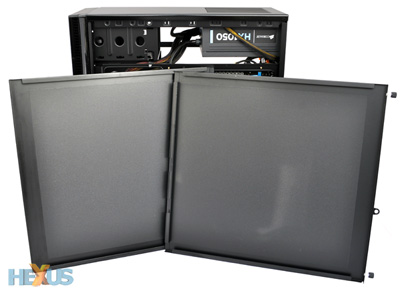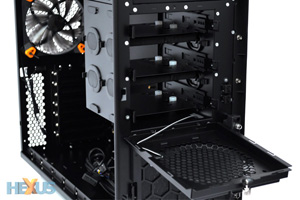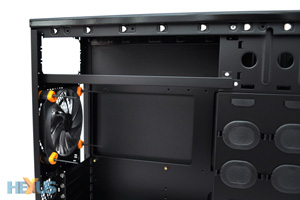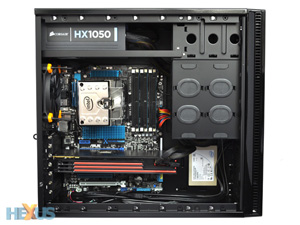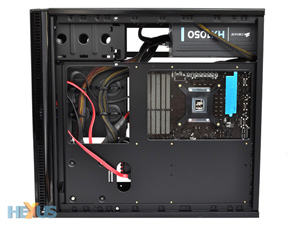Inside the SOLO II
Removing the SOLO II's side panels reveals the pre-attached polycarbonate layer - it's there to absorb noise and the same material is applied to the roof of the chassis, too.
The steel side panels feel suitably stiff and rigid, and the captive spring-loaded thumb screws are another very nice addition - though, it's a shame they only feature on the left panel. The right is held in place by standard Phillips-head screws. And, like SilverStone, Antec makes the mistake of bundling an assortment of silver screws. In an all-black chassis, black fixtures and fittings would be far more attractive.
We've mentioned that the SOLO II's relatively-tight confines can make it tricky to work with, but Antec has introduced a few tweaks designed to help make the build process a little bit easier. To begin with, the trio of hard-disk bays can be accessed from the front. The entire front bezel swings open (once the left side panel is detached) and can then be lifted up off its hinges for removal. With the chassis laid bare, the top fan filter drops open by undoing a single thumbscrew. The hard-disk access route isn't the quickest we've ever seen, but it certainly makes hard-disk installation feel more comfortable.
Likewise, power supply installation has been made simpler through a removable securing bracket. The entire arm can be pulled out after undoing four screws, making it easy to slot in a power supply before re-securing.
Elsewhere, there's a good-sized cutout in the motherboard tray to help with CPU cooler installation, and a selection of cable hooks attached to the rear of the hard-disk cage.
Those cable hooks really come in handy, as there's not a great deal of room between the motherboard tray and side panel - making it a tad more tricky to maintain a clean-looking build.
Not impossible, though, as our completed X58 test system looks rather good, with plenty of room for a Radeon HD 6970 graphics card and minimal cable clutter. The chassis is by no means easy to work with, and we often became frustrated by having to squeeze cables through seemingly-impossible gaps, but with a bit of time and a lot of patience, a high-end rig can be installed quite nicely.
There's ample room for dual graphics cards setups, and during installation we happened to stumble across a handy little mount for a solid-state drive. The dedicated 2.5in bay sits with its back against the wall below the hard-disk cage, and it's a clever way to add an extra storage bay. Though, if you're building an SSD-only system (like our test platform), it's a shame there's no option to remove the 3.5in hard-disk cage completely.
The SOLO II isn't as configurable or as feature-packed as some of its immediate rivals, but it remains a tidy-looking package and, provided it's both cool and quiet, it should retain plenty of appeal.






